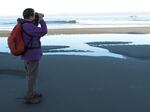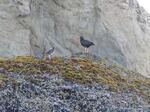Some say they’re orange, others say pink. But whatever color the bright beaks of black oystercatchers are, they stand out against the squeaky bird’s stark black feathers. And against the backdrop of their nesting habitat: boulders encrusted with mussels and chalky barnacles.
Diane Bilderback tracks where black oystercatchers make their nests and whether chicks survive. She showed me a spot in August here in Bandon on the southern Oregon Coast where these birds do better than in other areas.
“OK, now you can see the chick. It’s coming up to the parent,” she tells me. “There’s two nests there and one of them almost always hatches quite a few chicks.”
Black oystercatchers are a species of high conservation concern. The southern Oregon Coast tends to support a higher number of them compared to the northern coast. That’s where I joined volunteer oystercatcher monitor Tabea Goossen at Chapman Point near Cannon Beach.

Diane Bilderback on her black oystercatcher monitoring route in Bandon, Ore.
Kate Kaye / JPR News
Goossen points out a spot where this spring, a pair of oystercatchers lost chicks the first time they attempted a nest.
“I knew the nest had failed based on their behavior,” she says.
They tried a second time and those chicks lived. But all the other black oystercatcher nests on Goossen’s route — five of six — failed. Now, there’s concern that an increase in the number of people visiting the Coast could worsen the challenges facing these birds.
A Travel Oregon report estimates the volume of overnight visitors to the coast rose from 17 million in 2017 to 17.6 million in 2019. More people means more dogs getting too close to the rocks where oystercatchers nest. It means more people climbing those rocks, despite signs saying not to.
It also means more of the latest human disturbance — drones.
Bilderback tells me a drone can be deadly if an oystercatcher perceives it as a predator and flies after it, leaving the nest unprotected.
“During that time is a good time when the peregrine falcon can swoop in and get a chick,” she says.
Related: ‘There aren’t a lot of other options:’ Port Orford’s season of crab and crisis
Bilderback says black oystercatchers indicate the health of their intertidal ecosystem because they only eat species that live close to the shore: invertebrates like mussels and crabs.
“You’ll be seeing this oystercatcher come up with this worm in their bill. It’s really cool,” she says with a laugh.
People may not realize that if they carelessly trample over tidepools, they could squash the food the oystercatchers rely on.
Groups have submitted proposals to the state that would create stewardship programs to raise awareness about the impact of human disturbance on these birds and their habitats. The proposals also aim to designate several coastal spots as conservation areas. Most don’t create new restrictions.
But up north near where so many nests failed, proposals for Ecola and Chapman Points call for some new rules. They’d require dogs in proposed boundaries to be on leash — and they’d prohibit all commercial and most recreational harvesting of invertebrates like mussels and crabs.

An adult black oystercatcher stands with a chick high up on a rock near at the shore in Bandon, Ore., on the southern Oregon Coast.
Kate Kaye / JPR News
Margaret Treadwell is the coordinator for the North Coast Rocky Habitat Coalition who helped put together those proposals.
“To the extent possible we want to minimize negative impacts on people’s lives,” she says.
But her group discovered that the site boundaries originally considered would’ve blocked commercial crabbers from setting crab pots right up to rocky areas.
That concerned north coast crabber John Corbin.
“Fishing right up to them can be sometimes pretty good,” he says.
In keeping with the state’s collaborative process, crabbers like Corbin worked with Treadwell’s group to adjust the boundaries. Corbin says the process worked out pretty well.
“They were very interested and they didn’t wanna do anything that was going to hurt the crabbing end of thing,” he says.
All these rocky shores proposals will be made available by the state in March for public comment — part of a community-led process Treadwell says is a big deal.
“‘Cause you don’t always have the opportunity to suggest to a state agency certain areas for special protections.”
If approved, she and others hope the new conservation areas reduce human impact on the black oystercatcher’s habitat along the Oregon Coast.